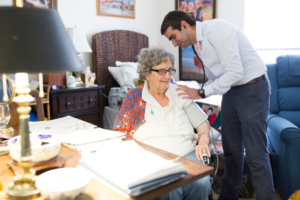Are you attempting to weigh assisted living versus nursing home care as an option for yourself or a family member? Many Americans just like you are doing exactly that. They’re looking for clear answers about senior living possibilities and the differences between them. Thankfully, this article can help to find some of those answers.
With help from this article, you can start making informed decisions that result in a comfortable, connected, and care-focused quality of life for you or your loved one. After all, a lot of today’s nursing homes and assisted living facilities are warm, homelike communities where older adults enjoy kindness and respect, make new friends, entertain visitors, and pursue satisfying leisure activities.

As you’ll discover, there isn’t just one main difference between assisted living and nursing home care. Rather, each type of senior care community has several special and defining characteristics. In this article, you’ll learn more about those differences as they relate to the following aspects:
Terminology
The “assisted living vs. nursing home” topic is best understood when you know what each term means. It also helps to know the other terms that are frequently used for the same types of senior care options. To that end, here are basic definitions that begin to clarify the difference between nursing home and assisted living options.
An assisted living facility (ALF) is a place where seniors or adults with disabilities live semi-independently and receive limited help with certain day-to-day activities. Assisted living communities tend to provide various hospitality and personal care services, 24-hour emergency response protocols, and regular opportunities for recreation and social interaction. The exact levels of care and types of services that are offered vary from facility to facility and often depend on state regulations. Other terms that are sometimes used when referring to assisted living include:
- Assisted care
- Residential care
- Supportive housing
- Supported living
- Adult foster care (in facilities with no more than four residents)
A nursing home is a place where residents who cannot live independently receive extensive and ongoing care due to old age, disabling medical issues, or other kinds of physical or mental conditions that require continuous monitoring or supervision. Nursing homes tend to provide more frequent and comprehensive personal care services than what you will find in assisted living facilities. They also provide easier access to skilled nurses. In some cases, people use the following terms when describing nursing home care:
- Long-term care
- Extended care
- Rest home
- Care home
- Intermediate care home
A skilled nursing facility (SNF) is a specific type of nursing home (or a special unit within a nursing home) that focuses on providing services that can only be carried out by registered nurses (RNs) or licensed practical or vocational nurses (LPNs or LVNs). Skilled nursing facilities are mostly intended for people who need short-term medical care or rehabilitative services outside of a hospital following surgery or other serious medical treatments. Examples of skilled nursing care procedures include:
- Giving injections
- Inserting catheters
- Using aspiration devices
- Inserting IV feeding lines
- Treating widespread skin diseases
- Applying dressings to infected wounds
- Assessing and educating patients
- Planning, managing, and evaluating patient care
Personal care (also known as custodial care) is assistance that doesn’t require the skills of a registered or licensed nurse. That’s why personal care is a stronger focus within facilities that provide assisted living (vs. skilled nursing facilities, which have a stronger focus on skilled care for medical conditions). Examples of personal care services include:
- Helping residents eat, bathe, get dressed, or go to the bathroom
- Administering routine oral medications, ointments, or eye drops
- Applying creams for minor skin problems
- Repositioning residents in their beds
- Changing dressings for non-infected wounds
- Helping residents walk, get around in wheelchairs, or stay mobile through other means
- Assisting with routine maintenance of bladder catheters or colostomy bags
- Supervising residents who have dementia
Common Types of Residents
When it comes to weighing nursing home versus assisted living options, it’s essential to understand who is best served by each type of facility. That way, you can feel more confident in your decision-making while potentially avoiding a costly or unnecessary move later on.
Assisted living is usually suitable for people who:
- Are open to the idea of getting assistance
- Can benefit from a more socially engaging living environment
- Are able to walk or use mobility devices on their own
- Need a limited amount of supervision or personal care assistance
- Are lucid or have only mild cognitive problems
- Want or need to be free of the responsibilities of home ownership
Nursing home care is often necessary for people who:
- Need daily medical care and/or a lot of personal care assistance
- Aren’t able to walk or get around in other ways without help
- Are too sick or frail for home care
- Need round-the-clock supervision or monitoring
- Have severe problems with incontinence
- Are likely to need frequent visits to the hospital
- Have moderate to severe cognitive problems
- Have complicated medical, emotional, or mental conditions
- Resist when being given assistance
- Display problematic behaviors
Many assisted living facilities welcome residents who have early to middle-stage dementia, including people with Alzheimer’s disease. When those residents require 24-hour supervision (for their own safety and the safety of others), they often need to move into nursing homes that have special memory care units.
Typical Living Spaces
Everyone wants a comfortable living environment. That’s why most assisted living facilities and nursing homes strive to create warm, homelike atmospheres where residents can socialize and accommodate visitors. However, beyond that shared goal, these two types of senior living options tend to have some very recognizable differences when it comes to the actual living spaces they offer.
Assisted living facilities:
- Tend to feature private or shared apartment-style units or studios
- Often feature units with small kitchens
- Generally give residents a lot of freedom in decorating their spaces
- Provide communal dining rooms
- Provide a lot of shared recreational space
- Serve about 28 residents each day, on average, according to CDC
Nursing homes:
- Mostly offer shared or private hospital-style rooms
- Sometimes provide a little less freedom when it comes to decorating
- Provide communal dining and living areas
- Tend to offer less recreational space
- Serve about 88 residents each day, on average, according to CDC
Cost and Payment Methods
According to Genworth, in 2023, the national median cost was $7,944 per month for a shared room in a nursing home (vs. assisted living costs of $5,628 per month). For a private room in a nursing home, the cost was $8,898 per month. So, although costs vary from facility to facility, assisted living usually costs quite a bit less than nursing home care.
But looking at cost alone doesn’t provide the full picture. That’s because how you pay for services may play a larger role in determining your options. For example, many seniors rely on Medicare and Medicaid, but those government programs don’t always provide the necessary coverage.
When it comes to assisted living:
- Most residents (or families) pay out of their own pockets.
- Some people are covered through private long-term care insurance.
- Many former military members (and/or their spouses) are able to pay using veterans’ benefits.
- Some states provide Medicaid coverage if you meet certain eligibility criteria.
When it comes to nursing home care:
- Most residents, if they are eligible, pay for it with Medicaid.
- Some people pay for it out of pocket or with private long-term care insurance.
- Under certain conditions, some patients receive temporary coverage through Medicare.
Medicare Part A, which is a federal government program, will temporarily cover the costs of care in a skilled nursing facility (SNF) under specific conditions. Medicare.gov says that, in order to qualify, a patient must have spent at least three days in the hospital prior to his or her stay in an SNF. Medicare will then fully cover the costs of care for the first 20 days in the SNF. After that, Medicare will continue to pay a portion of the costs for up to a total of 100 days. (During that time, a patient will need to pay a copay of over $214 per day.) When Medicare coverage runs out, the patient must cover all costs of care in the SNF.
In contrast, Medicaid is often used to pay for extended stays in nursing homes (and, less commonly, in assisted living facilities). Medicaid is a joint program of the federal government and individual state governments. Each state gets to set its own eligibility criteria for Medicaid benefits. As a result, the rules about long-term care coverage vary from state to state.
In general, however, a long-term care resident can often qualify for Medicaid coverage if he or she meets a few basic conditions. First, the long-term care facility must be licensed by the state and accept Medicaid payments. Second, the resident must have proof from his or her doctor that the long-term care is medically necessary. Finally, the resident may have to prove that his or her income and financial assets fall below a specific state-mandated threshold.







